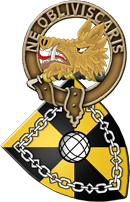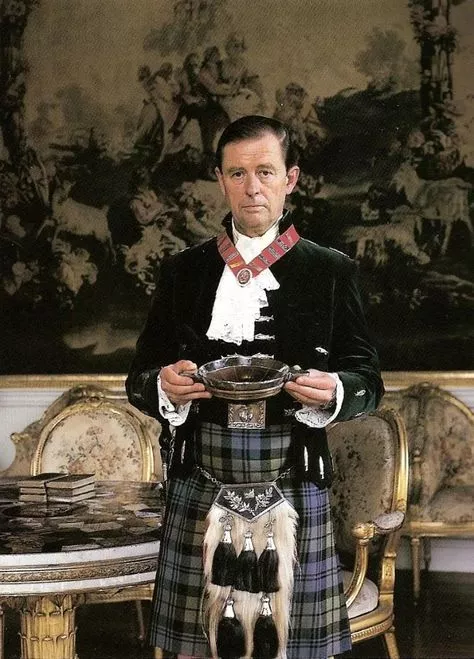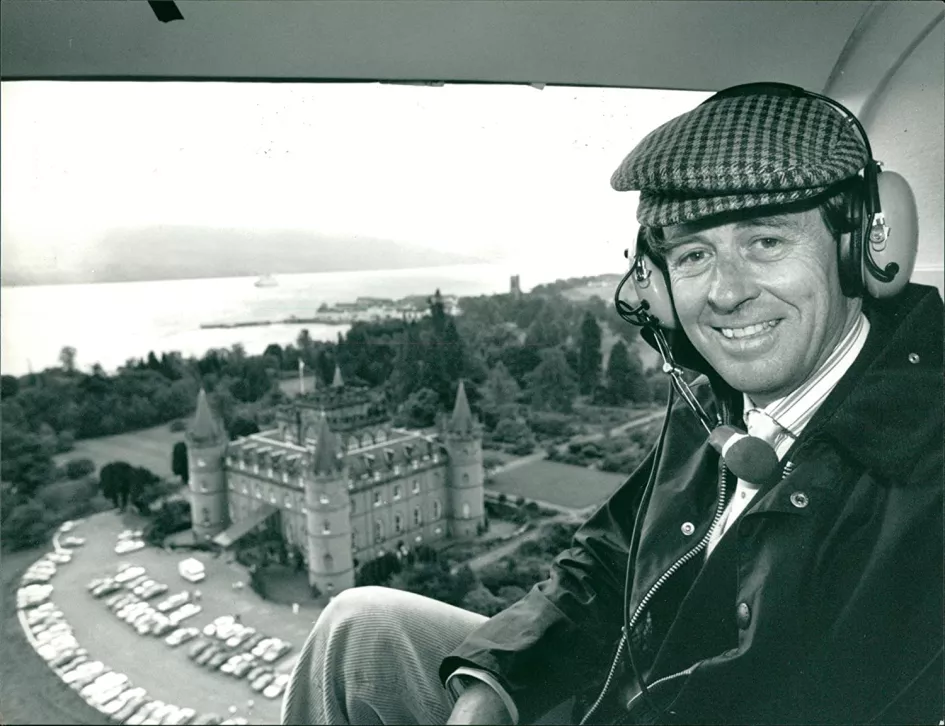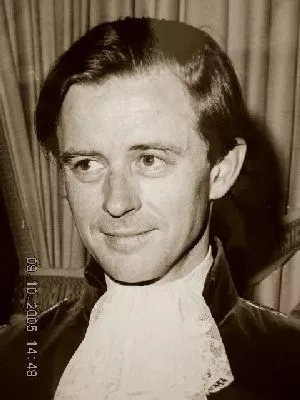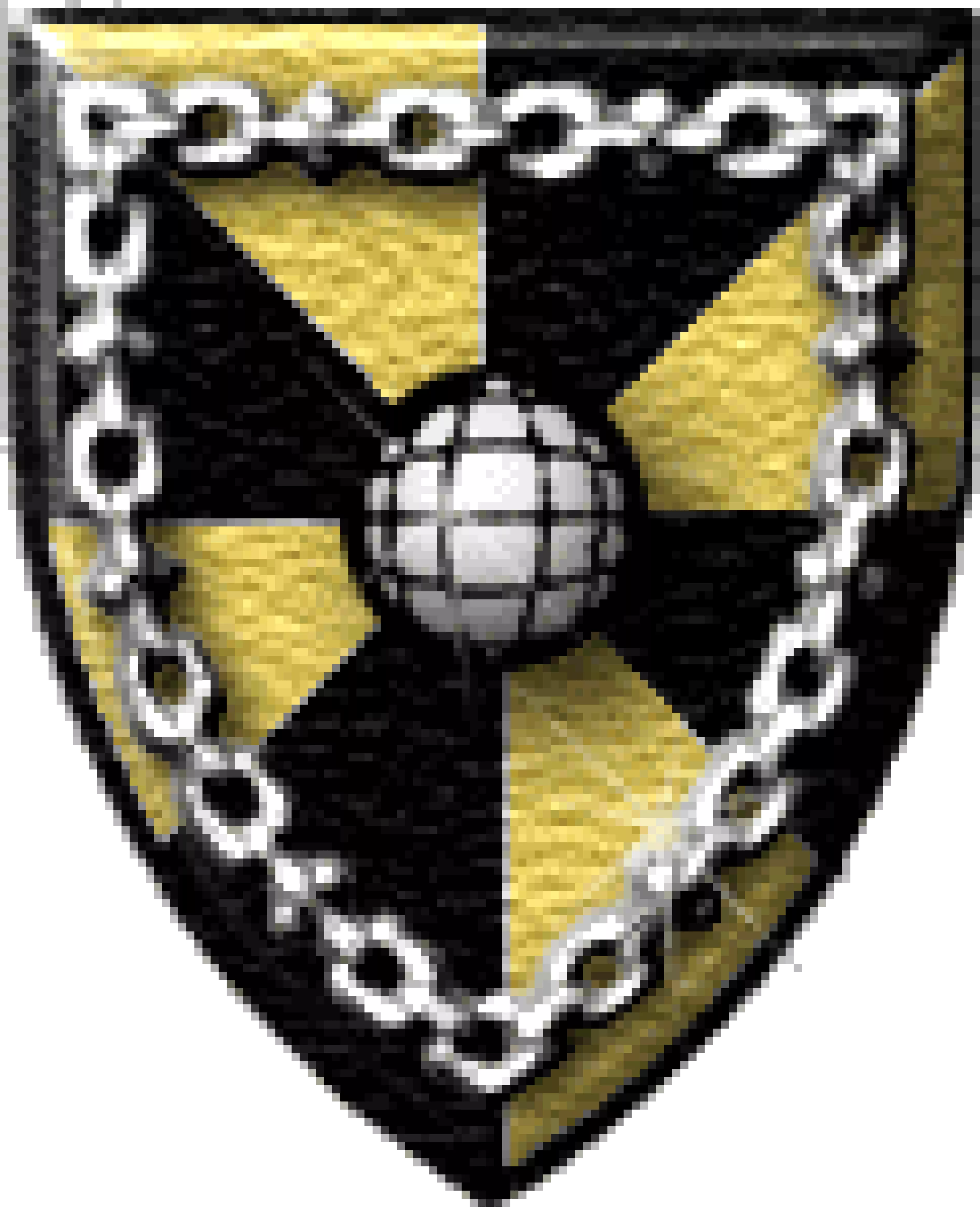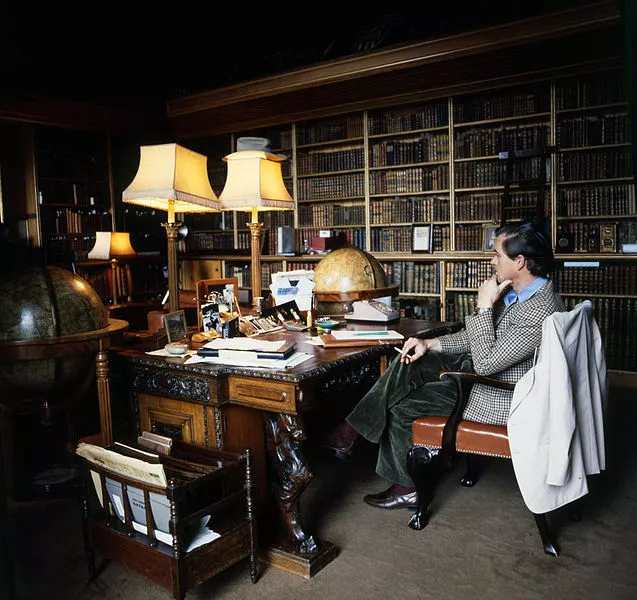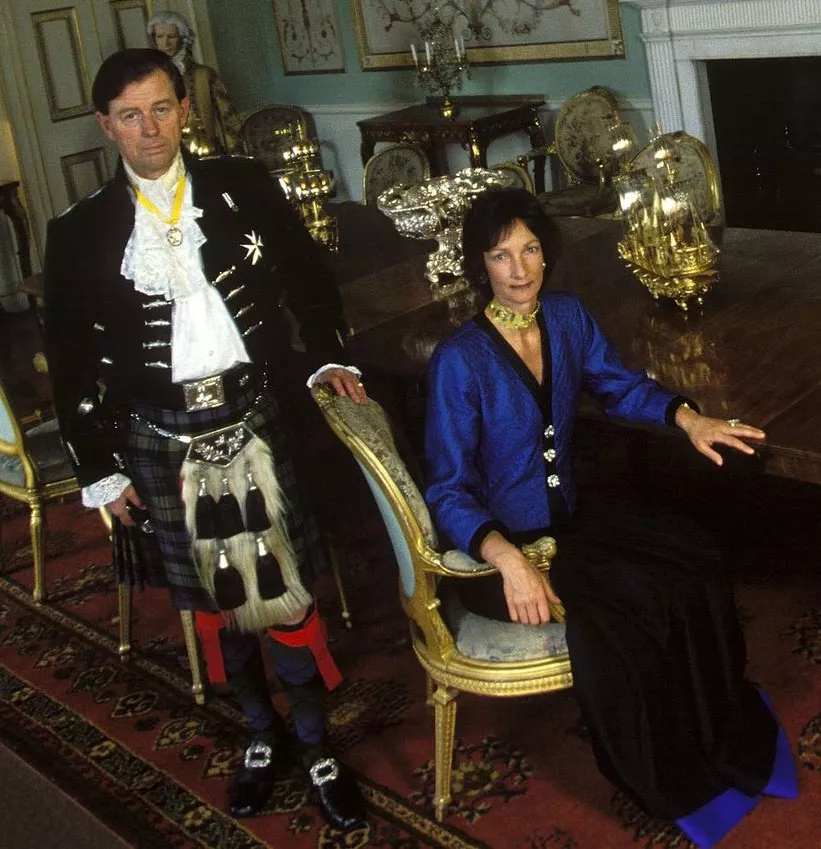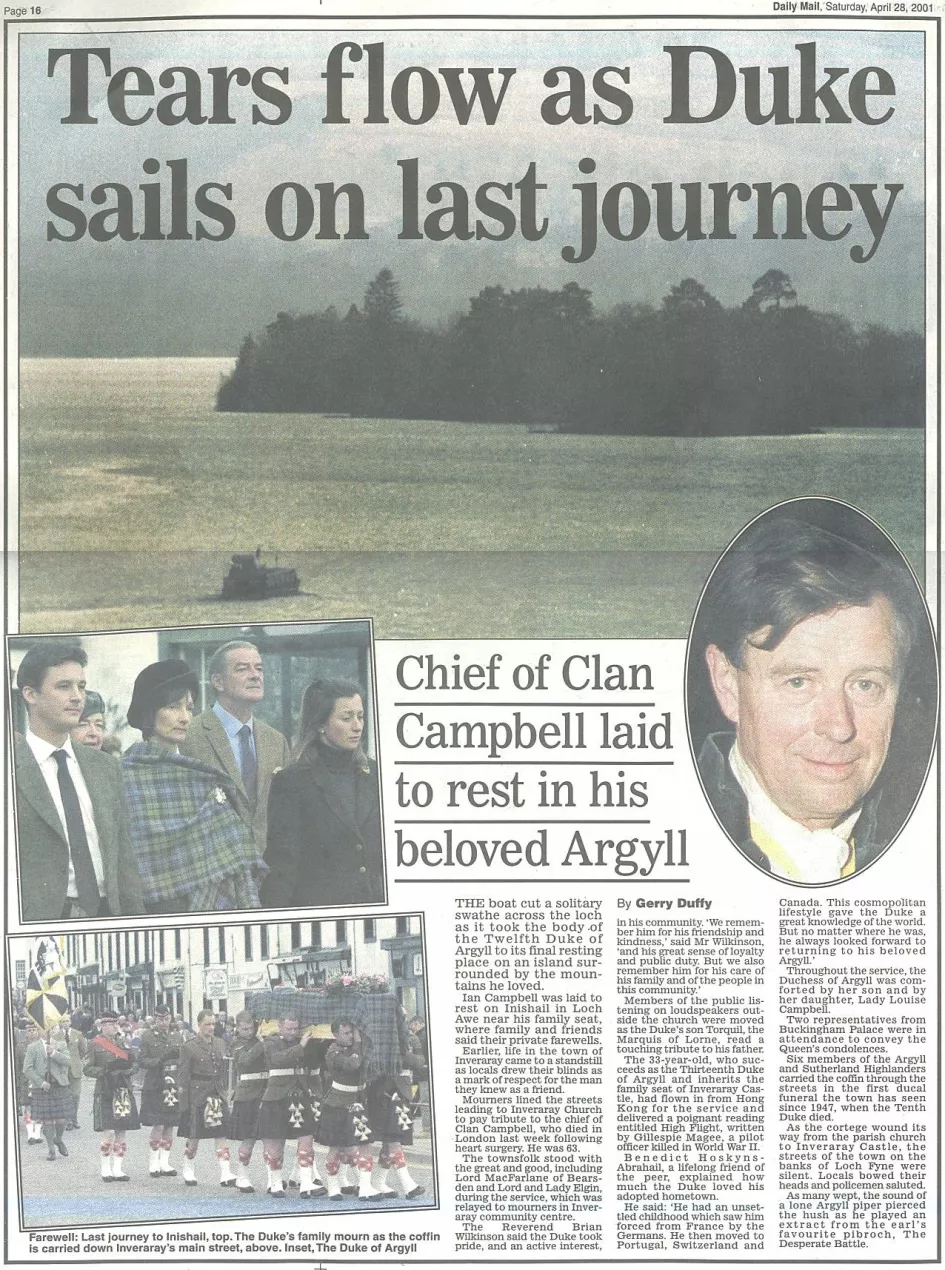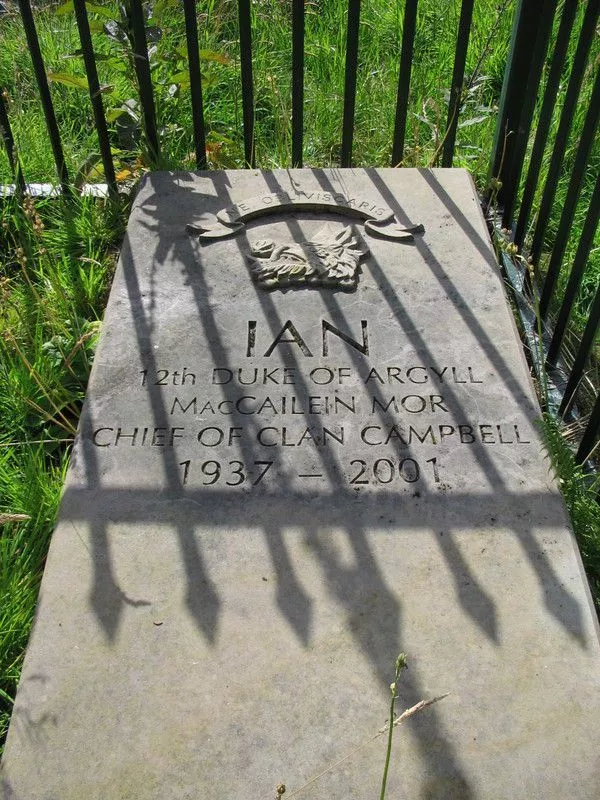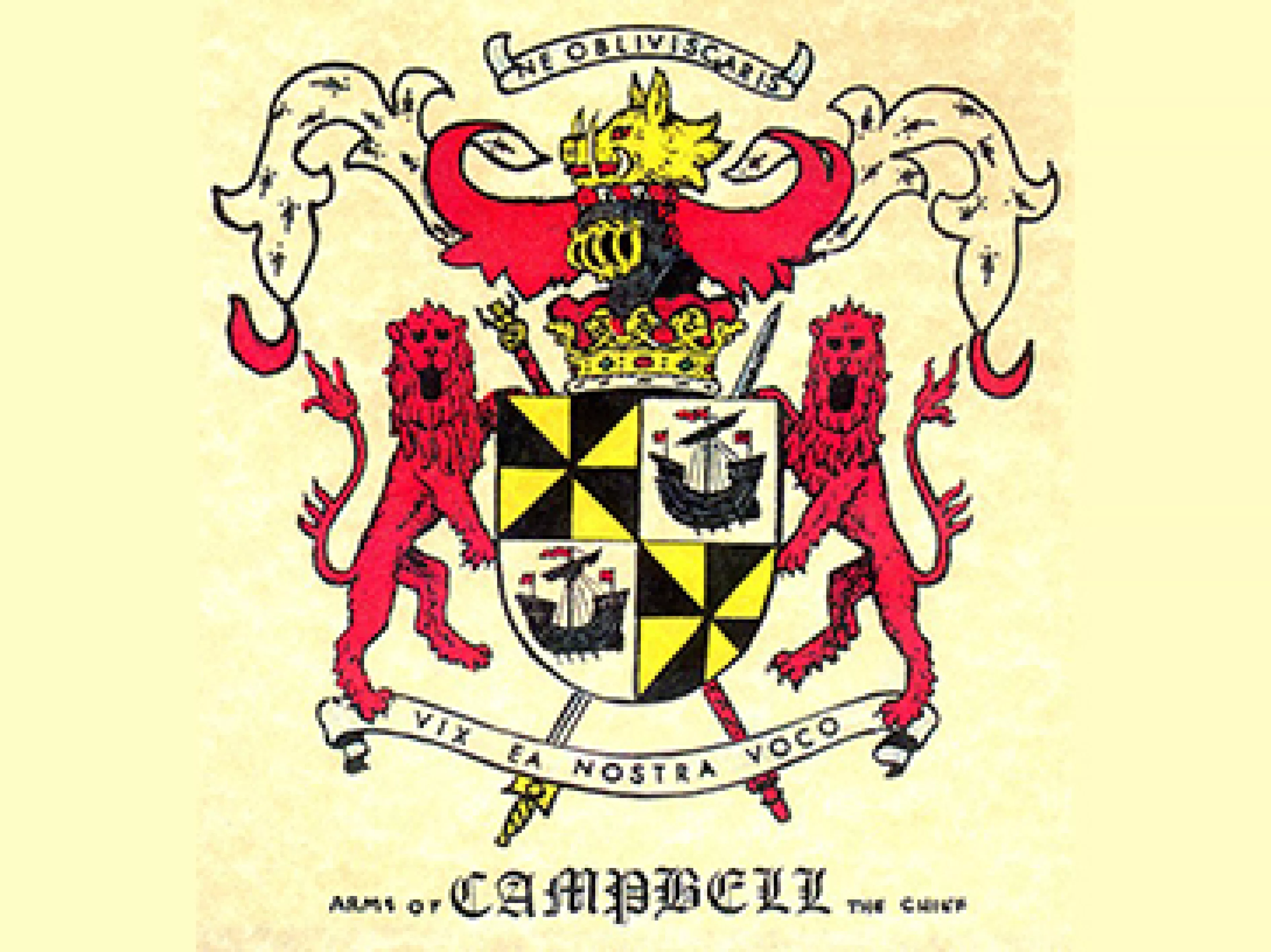Ian Campbell, 12th Duke of Argyll (S), 5th Duke of Arygll (UK), DL, K.St.J., FRSA (1937- 2001)
Ian Campbell, 12th Duke of Argyll (S), 5th Duke of Arygll (UK), DL, K.St.J., FRSE was the eldest son of Ian Douglas Campbell, 11th Duke of Argyll (S), 4th Duke of Argyll (UK) and his second wife Louise Hollingsworth Morris Clews Vanneck daughter of American-born artist and sculptor Henry Clews Jr., and his first wife, New York socialite Louise Hollingsworth (née Morris) Gebhard. He was styled Marquess of Lorne from 20 Aug. 1949 till 7 April 1973.
5th Duke of Arygll (UK)
Since Ian and his mother were living in Paris with her family during the defeat of France in June 1940 and his father Capt. Ian Douglas Campbell had been taken as a POW during the defense of Dunkirk, the family fled south to Portugal to escape occupied France. Thus Ian Campbell's education began as a World War II refugee in Portugal, then later continued at Institut Le Rosey in Switzerland, and Glenalmond College in Scotland before going on to McGill University in Canada, where he studied electronics.
In 1953 Ian Campbell was made a Fellow of the Royal Society for the Encouragement of Arts, Manufactures and Commerce. The Society is better known as The RSA
After graduation, Ian earned the rank of Captain while serving in the Argyll and Sutherland Highlanders. Ian Campbell spoke seven foreign languages, and used his command of languages effectively in business. He worked as a banker, and then four years as a export executive with Rank Xerox helping establish the company in the Soviet Union and Eastern Europe and was able to take credit when the first photocopy shop later opened in Moscow. In 1968 he took over the poorly run and deeply in debt Inveraray Castle estate from his father who was in declining health due to injuries sustained in World War II.
Following his success with Rank Xerox, in the 1980's Duke Ian rebuilt his family fortune by such ventures as £1,000 a week deer stalking trips at Inveraray and what is now known as ecotourism. He also pioneered selling his premium £245 a bottle 21 Year Old Scotch Whisky into the Japanese and far east markets, and other international businesses. Later in life his activities were concentrated more locally on increasing the Argyll estate's profits by putting in caravan parks, and on companies such as the Aberlour Glenlivet distillery.
Helicopters over Inveraray Castle
It was only in 1949 that his father succeeded his cousin Niall Diarmid Campbell, 10th Duke of Argyll to become the 11th Duke. Duke Ian is quoted as saying, "The first time I saw (Inveraray) castle was when I was nine and my parents had come to have tea. They made me wait outside in the car with the chauffeur. It was just another big house to me. Until then I'd never heard of it - and certainly not that one day I would inherit it." His mother did not even tell him that he was Marquess of Lorne when his father became the 11th Duke.
The 11th Duke's family was engulfed by scandal and negative publicity between 1959 and 1963, when his father divorced his third duchess, the former Margaret Sweeney, in Britain's longest divorce case. It featured compromising photos of the "dirty duchess" with a ''headless man.'' Every day in court, "Little Ian" could be seen sitting side by side with his father "Big Ian" even during the worst of it. The intense worldwide attention that the case attracted probably helped explain why Duke Ian became a reserved figure who liked to say his only wish was to keep ''a low profile behind my ramparts.'' Who could blame him?
In 1975, two years after he inherited the title from his father, lightning caused a fire that swept through Inveraray Castle destroying much of the structure as well as ancestral portraits by Gainsborough and Raeburn, some of the estate’s chief movable assets. This was the third time that fire had devastated the castle. The previous times being in 1877 and in 1950. The citizens of the Town of Inveraray were instrumental in saving many of the castle furnishings and valuable artifacts. Much to the credit of local residents, not one item removed from the castle turned up missing in the inventory after the fire. The Duke and Duchess were deeply moved and grateful by this act of honesty, respect and loyalty.
Lesser men would have left the castle a burned out ruin and moved on as so many others had done. The 12th Duke undertook the challenge to raise the £2 million (£17,851,632 or $24,271,079 US Dollars in January 2022) for repairs, especially among Campbell kin outside of Scotland. He traveled the world and with the help of local Clan Campbell Societies held fund-raising campaigns in the United States, Canada, Australia and New Zealand, where many of his clan had settled. While the repairs were under way, the young family of four spent months living in the castle dungeons without electricity or running water. Three years later, the castle reopened to the public.
Death taxes in Britain are a heavy burden for those who inherit. In 1950, heavy death taxes forced his father the 11th Duke to sell off nearly 29,000 acres of prime Argyll farm land. In 1979, history repeated itself. The first was a massive bill for death duties following the death of the 11th Duke in 1973. A tax specialist at a Glasgow law firm was reported as assessing the deferred liability as over £760m by 1984, though this may well have been a printer’s error for £76m. (According to the Bank of England calculator, £76m is equivalent to £259,929,505 or $353,738,064 US Dollars in January 2022. That was at least TWELVE times the value of the entire estate!) But at least some kind of deferral could be arranged with the taxman in exchange for conservation pledges regarding various landmarks and sites of national importance. Even so the estate, estimated at 70,000 acres, was diminished by the sale in 1979 of the beloved Island of Iona, the Hebridean island that had been under Campbell stewardship for hundreds of years (for 50 years in the 14th Century and returned to the Campbells late in the 15th Century where it remained until the sale) and that had been the cradle of Celtic Christianity since A.D. 563.
The price negotiated was £1.5m (£19,302,674 or $26,269,009 US dollars in January 2022). Meanwhile the lease of sporting rights brought in some revenue, but never enough. The estate had been put into trust by the time the 12th Duke died in 2001, thus avoiding an additional estimated £12m (£21,118,034 or $28,733,197 US dollars in January 2022) inheritance tax bill. The Argyll Estate was now a fraction of it's former 1877 size of 175,000 acres, but it has endured to this day.
Seeing a need among the various Clan Campbell organizations, The Federation of Clan Campbell Societies was created in 1986 by the 12th Duke of Argyll, to enable the various Clan Campbell Societies worldwide to use heraldic arms as granted to the Chief by the Lord Lyon King of Arms of Scotland, by the Federation. The Chief went to considerable lengths and expense to obtain this grant of arms from the Lord Lyon for The Federation so that each Society, who was a member of The Federation, could use them property as required by the traditions and laws of Scottish heraldry.
Queen Elizabeth II appointed the 12th Duke to the post of HM Lord Lieutenant of Argyll and Bute in 1994. The 12th Duke was one of a long line of Campbells to hold the position of HM Lord Lieutenant of Argyllshire and later HM Lord Lieutenant of Argyll and Bute.
Inveraray Castle, Scotland
Although he avoided the limelight and seldom took his seat in The House of Lords, the Duke set off controversy in Scotland by seeking to correct what he saw as 300 years of bad press for the Campbells. In particular, he sought to accurately report the details of 1692 Glencoe massacre of 38 members of Clan MacDonald. As the 12th Duke frequently pointed out, the massacre was entirely planned in London and Edinburgh and was solely an operation of the British army under the orders of King William III and masterminded by the Secretary of State over Scotland and Lord Advocate, John Dalrymple, Master of Stair. In no way whatsoever can it truthfully be called a "clan" event when, of the hundreds of men of the British army infantry company involved, only 13 were named Campbell and six had Clan Donald names. This, as the 12th Duke found out, did not sit well with the Scottish tourist industry and the press which generated tens of millions per year in revenue retelling the false "clan revenge" story. He was harshly criticized for it.
Duke Ian was fiercely proud of Clan Campbell, and more so of being Mac Cailein Mòr, Chief of Clan Campbell. He often said it was his "greatest honour". The 12th Duke frequently traveled worldwide to visit with Campbells and Clan Campbell Societies, often bringing his family with him. It was not uncommon to see him sitting in a Clan Campbell tent at a highland games regaling everyone with his encyclopedic knowledge of Clan Campbell history. He was everything one would expect of a Highland Chief and yet he was down to earth and approachable.
Inveraray Castle June 1994
Married: 4 Jul 1964 Iona Mary Colquhoun, the daughter of the late Sir Ivar Iain Colquhoun of Luss 8th Bt., Chief of Clan Colquhoun, by his wife Kathleen Nimmo Duncan, daughter of Walter Atholl Duncan, Cadogan Square, London, England.
Children:
1. Torquhil Ian Campbell, Earl of Campbell, later Marquess of Lorne, later 13th Duke of Argyll (S), 6th Duke of Arygll (UK) (see link below)
1. Lady Louise Iona Campbell (b. 26 Oct 1972), married: 18 Apr 1998 Anthony Merrik Burrell (b. 10 Jan 1969), 2nd son of Mark William Burrell, of Bakers House, Bakers Lane, Shipley, Horsham, co. Sussex (by his wife Margot Rosemary Pearce Munro, former wife of Mackenzie Munro and 2nd dau. of Westray Pearce, of Killara, New South Wales, Australia), 2nd son of Lt.Col Sir Walter Raymond Burrell, 8th Bt. CBE DL, by his wife Hon Anne Judith Denman OBE, only dau. of Thomas Denman, 3rd Baron Denman of Dovedale and Hon. Gertrude Mary Pearson.
Children of Lady Louise Iona Campbell and Anthony Merrik Burrell:
1. Teale Iona Burrell b. 11 Feb 2005
2. Albert Westray Burrell b. 4 Feb 2009
Ian Campbell, 12th Duke of Argyll, Chief of the Clan Campbell, who rebuilt Inveraray Castle after a disastrous fire, whose honest views on Scottish history drew sharp criticism, died in London, England during heart surgery. He was 63.
Born: 28 Aug 1937
Died: 23 Apr 2001, London, England
Tenure: 7 Apr 1973 - 23 Apr 2001 (28 years, 17 days)
Titles and Honors: He succeeded as the Chief of the Honorable Clan Campbell, Mac Cailein Mór on 7 April 1973.
He succeeded as the 22nd Lord Campbell [S., 1445] on 7 April 1973.
He succeeded as the 21st Earl of Argyll [S., 1457] on 7 April 1973.
He succeeded as the 21st Lord Lorne [S., 1470] on 7 April 1973.
He gained the title of 15th Lord of Kintyre [S., 1626] on 7 April 1973.
He succeeded as the 14th Baronet Campbell, of Lundy in Angus, co. Forfar [N.S., 1627] on 7 April 1973.
He succeeded as the 12th Duke of Argyll [S., 1701] on 7 April 1973.
He succeeded as the 12th Marquess of Kintyre and Lorn [S., 1701] on 7 April 1973.
He succeeded as the 12th Earl of Campbell and Cowall [S., 1701] on 7 April 1973.
He succeeded as the 12th Viscount of Lochow and Glenyla [S., 1701] on 7 April 1973.
He succeeded as the 12th Lord of Inverary, Mull, Morvern and Tirie [S., 1701] on 7 April 1973.
He succeeded as the 8th Baron Sundridge, of Coomb Bank, Kent [G.B., 1766] on 7 April 1973.
He succeeded as the 9th Baron Hamilton of Hameldon, co. Leicester [G.B., 1776] on 7 April 1973.
He succeeded as the 5th Duke of Argyll [U.K., 1892] on 7 April 1973.
He held the office of Hereditary Grand Master of the Royal Household [Scotland] on 7 April 1973.
He held the office of Keeper of the Great Seal [Scotland] on 7 April 1973.
He held the office of Keeper of Dunstaffnage, Carrick, Tarbert and Dunoon Castles on 7 April 1973.
He held the office of Admiral of the Western Coasts and the Isles on 7 April 1973.
He was admitted to the Royal Company of Archers. in 1977
He was appointed Knight, Most Venerable Order of the Hospital of St. John of Jerusalem (K.St.J.) in 1975.
He was Chairman of Beinn Bhuidhe Holdings in 1977-2001.
He was Director of S Campbell & Son 1982-2001.
He was Director of Aberlour Glenlivet Distillery Co, White Heather Distillers, Muir Mackenzie & Co 1973-2001.
He was Director of Visual Sound Programmes 1970-2001.
He was President of the Royal Caledonian Schools; Argyll Scouts Assoc.; and the Highland Society of London 1985-90.
He was honorary Colonel of the Argyll and Sutherland Highlanders Battalion, Army Cadet Force between 1981 and 1991.
He was a director of S. Campbell & Son in 1982.
He held the office of Deputy Lieutenant (D.L.) of Argyll and Bute between 1987 and 1994.
He held the office of Lord-Lieutenant of Argyll and Bute between 1994 and 2001.
Preceded by: father Ian Douglas Campbell, 11th Duke of Argyll (S), 4th Duke of Argyll (UK)
Succeeded by: eldest and only son Torquhil Ian Campbell, 13th Duke of Argyll (S) and 6th Duke of Argyll (UK)
Burial: Loch Awe Inishail Old Parish Churchyard, Inishail, Argyll and Bute, Scotland
Ian Campbell, 12th Duke of Argyll, Find a Grave Entry
